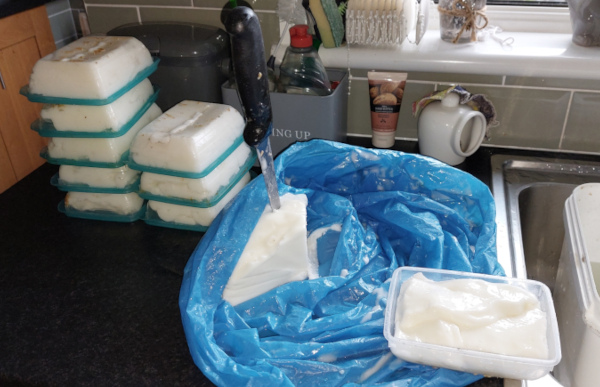Supplementary Feeds
Honeybee colonies require constant access to supplies of stores (honey and pollen) across all seasons. When there are not enough stores in the nest to sustain the colony it becomes necessary to provide supplementary feed to avoid a catastrophe. This may be due to one or many of several factors. In the wild colonies see to this themselves in they way they manage their nest and stores to provide adequate provisions across the seasons, but when they are hived it becomes a different matter. The following are the most common occasions when to consider using supplementary feeds and a range of feeds / supplements that can be used.
Early Spring - In early spring when the colony is coming out of winter their stores may be running out, and foraging opportunities to replenish them sporadic due to unsettled weather. On top of this spring management often includes swapping old blackened comb for new foundation, the colony which will be starting to build up may need supplementary feed for sustenance and wax production for building new comb in which more brood will be produced. Supplementary feed of light syrup should be provided if the temperatures are above 8℃ or heavy syrup if its colder. Pollen / protein substitutes can also be put on at this point to aid brood development and give the colony a boost.
June Gap - When honey has been harvested in late spring / early summer, there follows a dearth of forage opportunities for a few weeks when the spring flowers have disappeared and the summer flowers are yet to appear (the June gap). The colony will be at its strongest now and will require significant amounts of stores to sustain them, stores that may no longer be available. Feeding with a light syrup mix will sustain them until foraging opportunities return.
New Colonies - Nucleus colonies from splits or nucs will have little in the way of stores and will be busy dividing their labour across foraging, nest building and nursing brood. They will need sufficient stores to sustain them and for producing the wax required for comb building to increase the nest size. Providing a light syrup feed greatly assists the colony and speeds up the colony build up keeping in mind it will need to be strong enough by the end of the summer to go successfully through the winter.
Swarms - A swarm carries with it a supply of honey specifically for building a new nest but this supply quickly runs out and they will depend on what forage is available and being brought in. The swarm will be greatly helped by the provision of light syrup feed to supplement their limited stores and will speed up the development of the nest and colony.
Winter Preparation - As Autumn comes to an end the stores in the hive have to be sufficient enough to sustain the colony from when forage ends right through winter to early spring when forage begins again. This might be as long as 5 months. A late summer crop of honey may have been taken off leaving the colony short for the winter months or it may simply not have had the opportunity to build up enough stores. Supplementary feed of heavy syrup is required as long as the temperatures are above 8℃, less then this and the bees will not be able to reduce the water content down sufficiently to invert it and what is stored will ferment very quickly and cause dysentery. When temperatures have dropped below 8℃ fondant, candy or sugar bags should be used. These will keep well over the winter season.
Syrup Feeds
Syrup feeds can be purchased from your bee supplies shop in small container or bulk form. Alternatively you can make your own from bags of sugar or from honey that is not suitable for jarring or has crystallised over winter.
Light Syrup Feed - used to supplement honey stores in late spring and summer, to help new colonies from splits and nucs, and newly housed swarms. Usually fed by means of contact feeders in warmer weather. If the temperature is low consider using heavy syrup. To make light syrup boil 500 ml / 1 pint of fresh water in a kettle or heat in a heavy saucepan to boiling (100℃). Take off the heat and carefully add 0.5 Kg refined granulated sugar, stir continually until all the sugar has dissolved. Allow the mixture to cool then transfer to suitable clean containers. To prepare larger volumes of feed it is possible to use cold water, adding the sugar and stirring regularly. The sugar will eventually dissolve but will take much longer, however it does away with the need for heat.
Heavy Syrup Feed - used to supplement honey stores in late autumn and early spring in colder weather, and to help newly housed swarms build comb. Usually fed by means of contact feeders. To make heavy syrup boil 500 ml / 1 pint of fresh water in a kettle or heat in a heavy saucepan to boiling (100℃). Take off the heat and carefully add 1 Kg refined granulated sugar, stir continually until all the sugar has dissolved. Allow the mixture to cool then transfer to suitable clean containers. To prepare larger volumes of feed it is possible to use cold water, adding the sugar and stirring regularly. The sugar will eventually dissolve but will take much longer, however it does away with the need for heat.
Honey Syrup Feed - Often you will have honey that is not fit for extraction or jarring, or has become spoiled by crystallisation. This can be used as a syrup feed by mixing the honey with equal amounts of warm (not hot) fresh water. The bees will accept this readily from contact feeders and can be used whenever supplementary feed is required.
Shelf Life - the syrups are suitable for immediate use and will last while applied in contact feeders, but will eventually ferment when exposed to air, becoming soiled with fungal growth which will cause dysentery in the hive. Transferring the hot sugar syrup mix into sealed clean containers while above 50℃ will considerably extend its shelf life. Honey syrup shouldn't be heated over 30℃ in order to preserve its qualities. Alternatively the addition of Thymol (see below) will deter the fungal growth and increase shelf life.
Thymol in Syrup Feeds
The Thymol referred to in this text is the crystalline substance obtainable from your local bee supplies vendor and intended for use in honeybee care only.
Safety



Thymol is harmful to you and the environment. It occurs as a white crystalline powder or solid with a pungent smell. It is an irritant to skin and respiratory organs and can cause serious eye damage. Please read all safety data and safe use recommendations before working with Thymol. Work in a well ventilated area, and always wear appropriate Personal Protective Equipment. Store all Thymol products in a secure place to prevent accidental exposure.
Stock Solution - Thymol crystals are not readily soluble in water. In order to use in honeybee feeds it is necessary to first dissolve the crystals in a suitable spirit solution such as surgical spirit, methylated spirit, or isopropyl alcohol (these spirits are hazardous, read the safety information before use!). Once dissolved, the mixture or ‘stock solution’ can be stored for quite a long time in a sealed container. The recommended mix for a ‘stock solution’ is 30g Thymol crystals to 150ml spirit.
This strength of mix is widely known as ‘Manley Strength’, Rob Manley often being credited with first using Thymol in honeybee syrup feed. It is worth noting that where 3X or 4X Manley Strength is recommended, it does not mean three or four times as much Thymol on the spirit mix, but means instead that three or four doses of the stock solution should be used.
Use in Syrup Feeds - Sugar syrup on its own unfortunately has a tendency to ferment in the comb as it is being stored, especially over winter, as does any syrup kept stored in containers which will quickly develop the black fungal sludge rendering it unusable. Fermented syrup will cause bad dysentery in the colony and can encourage the spread of nosema, a fungal pathogen that affects the bee gut and spreads quickly around the hive. Adding a small amount 'stock solution' to the syrup will greatly improve its useable lifespan when stored ready for use in containers and when stored by the bees in the comb. The recommended general dose is 2.5ml stock solution to 4.5lt syrup (half a teaspoon of stock solution to one gallon of syrup which works out at just under 2X Manley Strength).
Storage - Use clean containers which can be sealed. Well rinsed plastic 2.2lt milk and 10lt Adblue containers are a convenient size and weight for storing and using home made thymolised syrup feeds.
Sugar Bags
Preparing Sugar Bags - A cost effective well tried and tested method used as a winter supplementary feed or for emergency rations. Prepare an unopened 1kg bag of granulated sugar by using a kitchen fork to carefully pierce the bag a few times to create small holes on the front and rear of the bag. Submerge the bag in the fresh water for a few moments to allow some water to penetrate, then remove the bag from the water and lay to one side to allow excess water to drain. Do not leave the bag submerged so long that the sugar inside turns to mush, it just needs the sugar dampened enough for it to hold together in the bag.
Using Sugar Bags - Place the prepared bag punctured face down directly on top of the brood frames and inside an empty super. A single bag should be over the cluster with the surrounding space filled with suitable insulation such as bubble wrap or polystyrene, or simply fill the super space with six prepared sugar bags. Complete the insulation by replacing the crown board with the vents closed. Bees will chew into the bag to access the sugar, and will throw the paper out of the hive entrance. Keep an eye on reduced entrances becoming blocked by paper and for sugar cascading down through the brood chamber if it is too dry.
Prepared sugar bags will keep well and ready for instant use in an airtight container stored in a warm and dry environment.
Fondant
Using Fondant Packs - A very popular winter feed that keeps well, obtained as preprepared 1 kg plastic packs from your favourite bee supplies shop or as 12.5 kg blocks of fondant from bakers suppliers. The soft fondant is readily accessible to the bees throughout the colder months when syrup is unsuitable. Packs of fondant only require an 8 - 10 mm slot of plastic cut out across one side then the pack placed slot down and across (not in line with) the brood frames inside an eke. Fill the unused space with insulation such as bubble wrap or polystyrene, replace the crown board with vents closed and remember to check occasionally that there is fondant left and that the cluster does have access to it. Replace or move the pack if not.
Using Bakers Fondant - Bakers fondant can be cut off in slices and placed inside grip seal plastic food bags prepared and used in an eke as with packs above. Alternatively low profile plastic food containers can be prepared by cutting an 8 - 10 mm slot along the container bottom and then filled with fondant. These can easily be refilled on-site and re-used again and again. Unused filled containers can be kept upside down in a sealed container or plastic bag to prevent the fondant drawing in moisture and spilling out.

Shallow food containers with a slot cut along the bottom make convenient fondant feeders that are easy to use and refill.
The containers shown cost very little from your favourite household bargain store and hold approx 0.5kg fondant each. These are placed inside an eke and directly on top of the cluster with the slot across the frames to allow access. The open space around the feeders can be filled with bubble wrap to minimise heat loss. Using glass quilts allows winter inspection without significant disturbance. Having pre-filled spares to hand makes replacement a quick and easy job.
Candy Blocks
Making Candy Blocks - Another cost effective solid sugar winter feed that can be prepared at home. To make candy blocks put 500 ml / 1 pint of fresh water in a large heavy saucepan and carefully add 2 Kg refined granulated sugar. Ensure there is sufficient depth of saucepan to accommodate the boiling froth which will occur at high temperature. Place on high heat and stir continually to avoid burning the mix. Continue to heat and stir the boiling mix until a temperature of 117℃ has been achieved then take off the heat. Keep stirring the mix as it cools, this can be speeded up by placing the hot pan on wet towels. The cooling mix will start to turn cloudy and stiffen up, as it does transfer the mix to the shallow take-away containers while still liquid. The resulting blocks of cold solid candy can be easily popped out of the plastic containers then placed in freezer bags and sealed ready for use.
Note: The mix will not set if the required temperature has not been reached, also avoid over heating and turning the mix to toffee.
Using Candy Blocks - The prepared candy blocks can be removed form their packaging and placed directly on top of the brood frames inside an eke and the remaining space filled with insulation as with fondant and sugar bags and the hive closed and sealed from draughts. Check occasionally to ensure there is feed left and move or replace the candy blocks as necessary. The candy blocks will absorb moisture and become soft over time if not used. Store unused blocks in sealed containers in a warm dry environment.
Protein and Pollen Substitutes
Using Protien / Pollen Substitutes - These products available from your favourite supplier contain pollen substitutes or similar ingredients that can be used in winter preparation to help sustain brood over the cold months or in the early spring as a stimulant to boost egg laying and colony build up when natural sources of pollen and nectar are not yet reliable. They are supplied in plastic bags or patty packs similar to fondant and are used in a similar manner, or in a solid block that can be cut into suitable slices and placed directly on top of brood frames. As with the other winter supplements, check occasionally to ensure sufficient feed and access to it.
Emergency Rations
Beekeeping is always full of surprises, not all of them good, in fact most surprises need immediate action and often require the keeper to think on their feet. Such an occasion would be when you discover a colony is on the brink of starvation and needs fed now, not later or mañana! In the absence of fondant, candy or a prepared bag of sugar, a frame of honey from another hive or left over from last season can be placed flat across the top of the brood frames as a temporary measure and will sustain your bees until a more permanent solution is available. Lightly score the surface of the down facing surface before laying on the frames to allow the bees easy and instant access.
At the end of the season there is always a frame or two of sealed honey that didn't make through the quality control. It can be used as described above or extracted and diluted in equal parts with clean water to make a syrup and as an emergency feed it will never go to waste.
Try the Colony Management Quiz
About the 'My Beekeeping Kit' website.
Contact Iain Dewar for enquiries, suggestions, corrections and contributions for improving the notes. Always welcome!